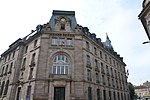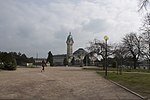Limoges Cathedral

Limoges Cathedral (French: Cathédrale Saint-Étienne de Limoges) is a Roman Catholic church located in Limoges, France. It is a national monument and the seat of the Bishop of Limoges. The cathedral is in the Gothic, Renaissance and Romanesque architectural styles. The construction of the church began in 1273 and finished only in 1888, when the nave was connected to the belfry, a fine, partly octagonal, bell tower. It is noted for its Renaissance rood screen with reliefs of the labors of Hercules, built in 1534 and moved to the western end of the nave during the revolution, and for the tomb of the bishop Jean de Langeac (who commissioned the rood screen) on which are carved scenes of the Apocalypse, inspired by Dürer.
Excerpt from the Wikipedia article Limoges Cathedral (License: CC BY-SA 3.0, Authors, Images).Limoges Cathedral
Rue Porte-Panet, Limoges Le Sablard
Geographical coordinates (GPS) Address External links Nearby Places Show on map
Geographical coordinates (GPS)
| Latitude | Longitude |
|---|---|
| N 45.828888888889 ° | E 1.2666666666667 ° |
Address
Cathédrale Saint-Étienne
Rue Porte-Panet
87000 Limoges, Le Sablard
Nouvelle-Aquitaine, France
Open on Google Maps










